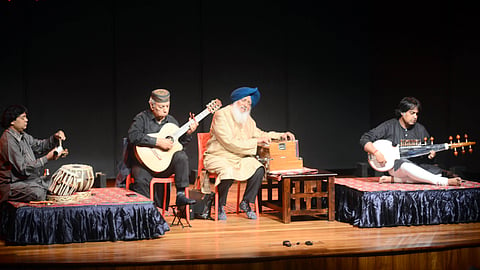

CHENNAI: The corridor walls of the Asian College of Journalism (ACJ) are filled with works of 280 artists — created over one and a half years ago. On the canvases, the artworks represent the voices of people echoing ‘Hum Sab Sahmat’ (We all agree). This exhibition is curated by The Safdar Hashmi Memorial Trust (Sahmat) and hosted by ACJ.
At the inauguration of Hum Sab Sahmat, Justice K Chandru, former judge of Madras High Court, points out the importance of the theme of inclusion and togetherness. He says, “Every religion is founded on the principle of unity and oneness. It is important because today, religion is used to divide people and this attempt of the exhibition is to bring religion and culture to a common platform where humanity prevails.”
Read the artworks
Pink flowers and green leaves embroidered on a white cloth with handwritten poems, ‘Hum sab phool hain’ (We are all flowers), ‘The Hypnosis of Existence’, ‘An Anthem of Resistance’, ‘Paani Maang Raha Tha Insaan’ (A man was asking for water); paintings of a man drowning in blood, a woman bearing a can on her head walking miles with no one in sight, stains of blood on a man’s palms, people rowing boats with their oars drawn as a musical note... these are a few frames hanging off the jute banners. “These are all the responses to the various happenings in the country in creative means. The exhibition is a unity of diverse people, ages, and language groups, ” says Ram Rahman, photographer and founding member of Sahmat.
“The exhibition expresses different feelings through diversified art forms. I felt the presence of the pain that went behind creating each work. It is a good opportunity for me to learn from the Hum Sab Sahmat theme,” says Abhishektha, a student of ACJ. Another student, Roshan Zahin, says, “I see a lot of inclusivity in every art of different languages and cultures. There is more abstract art and creativity which gives the audience a chance to form a perception. It is very open and gives you the space to understand the work in your way.”
Additionally, there is a photo exhibition curated by Ram Rahman and Saarthak Singh . It shows the last few days of Gandhi’s life, his death, and the days that follow through clippings of books and photographs clicked by Henri Cartier-Bresson, Max Desfor, and Margaret Bourke-white. “The photographs presented here have a rare history but very important for us,” adds Ram.
Freedom in music
The inauguration was followed by a Sufi music concert. “Art and music play a greater role. Sufi music is a synthesis of religion and the basis of it is love and affection,” says Chandru. In the evening hues, the band Chaar Yaar took the audience to on a journey from the 13th to the 21st century.
Explaining one of the songs, singer Madan Gopal Singh, says, “I am devastated, I am torn in bits and pieces just like the cloth bits in a tailoring shop. The tailor stitches them together and creates a beautiful outfit, similarly, I will mend together all my pieces and emerge to be a stronger one.” In one of the performances, guitarist Deepak Castelino engaged the audience, while Amjad Khan played percussion and Pritam Ghosal sarod. The exhibition and the concert aim to ignite the power of unification.
Hum Sab Sahmat will be held at the Asian College of Journalism till April 10 between 10 am and 6 pm
Entry free
Call: 22542842/43/44/45